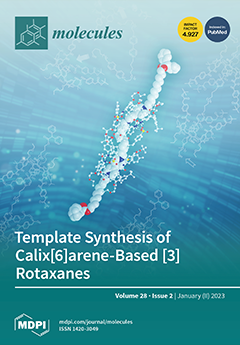Moringa oleifera, native to India, grows in tropical and subtropical regions around the world and has valuable pharmacological properties such as anti-asthmatic, anti-diabetic, anti-inflammatory, anti-infertility, anti-cancer, anti-microbial, antioxidant, and many more. The purpose of this study was to assess the free radical
[...] Read more.
Moringa oleifera, native to India, grows in tropical and subtropical regions around the world and has valuable pharmacological properties such as anti-asthmatic, anti-diabetic, anti-inflammatory, anti-infertility, anti-cancer, anti-microbial, antioxidant, and many more. The purpose of this study was to assess the free radical scavenging ability of two extracts and two pure compounds of
M. oleifera Lam (hexane, ethanol, compound E3, and compound Ra) against reactive oxygen species, as well as their reducing power and antimicrobial activities. Bioautography antioxidant assay, 2,2-diphenyl-1-picrylhydrazyl (DPPH), hydrogen peroxide (H
2O
2) free radical scavenging, and iron (iii) (Fe
3+ to Fe
2+) chloride reducing power assays were used to assess the extracts’ qualitative and quantitative free radical scavenging activities. Furthermore, the extract and the compounds were tested against both Gram-positive and Gram-negative bacterial strains suspended in Mueller–Hinton Broth. The extracts and pure compounds showed noteworthy antioxidant potential, with positive compound bands in the Rf range of 0.05–0.89. DPPH), H
2O
2, and Fe
3+ to Fe
2+ reduction assays revealed that ethanol extract has a high antioxidant potential, followed by compound E3, compound Ra, and finally hexane extract. Using regression analysis, the half maximal inhibitory concentration (IC
50) values for test and control samples were calculated. Compound Ra and ethanol exhibited high antioxidant activity at concentrations as low as
0.28 mg/mL in comparison with n-hexane extract, compound E3, ascorbic acid, and butylated hydroxytoluene standards. The radical scavenging activity of almost all
M. oleifera plant extracts against DPPH was observed at 0.28 mg/mL; however, the highest activity was observed at the same concentration for ascorbic acid and butylated hydroxytoluene (BHT) with a low IC
50 value of 0.08 mg/mL and compound Ra and ethanol with a low IC
50 of 0.4 mg/mL, respectively. The extracts and pure compounds of
M. oleifera have little to no antibacterial potential.
M. oleifera extracts contain antioxidant agents efficient to alleviate degenerative conditions such as cancer and cardiovascular disease but have little activity against infectious diseases.
Full article






